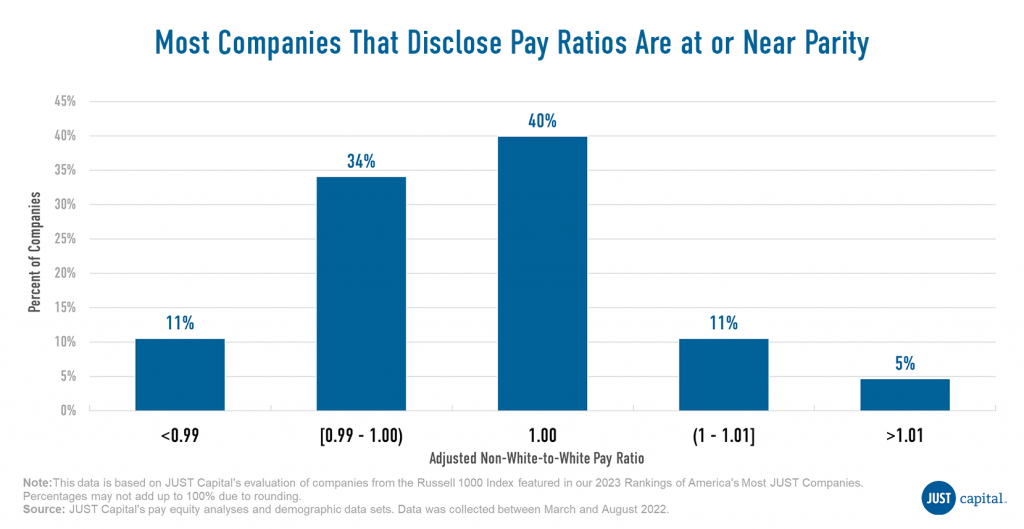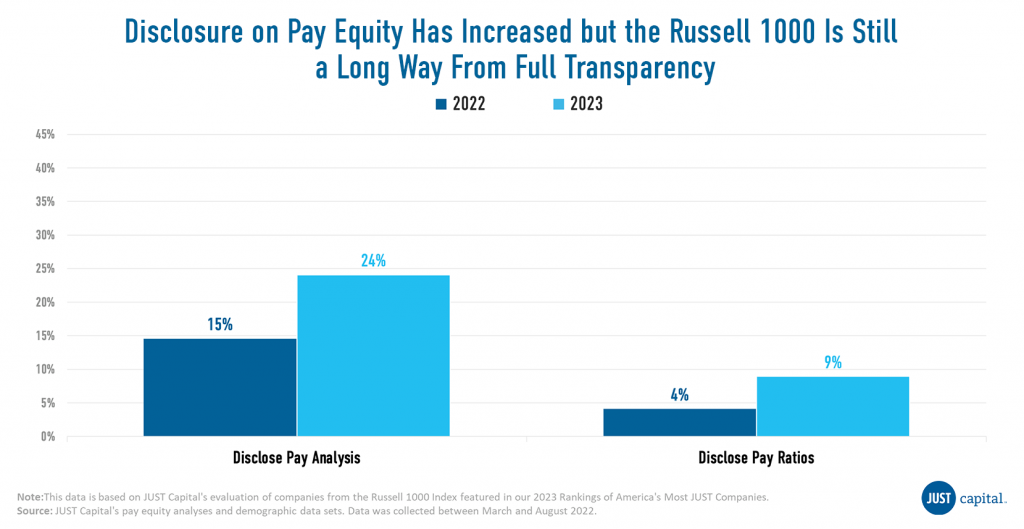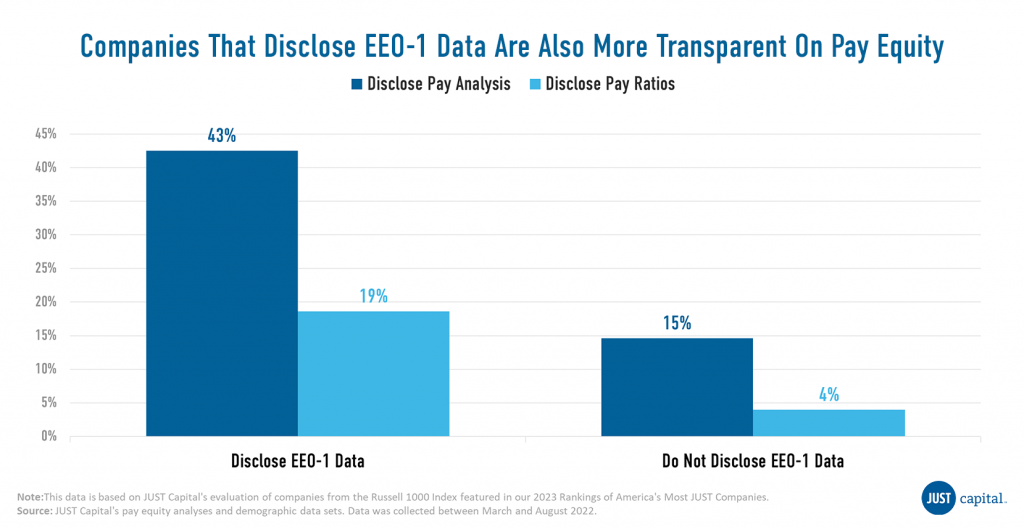JUST Report
Transparency on Racial Pay Equity Increased From 15% to 24% in 2023, With Disclosure More Common Among Companies That Disclose Detailed Demographic Data
- More Reports
- View all JUST Reports
Despite Rising Disclosure Trends, Just 6% Disclose Both Detailed Demographic Data and Race/Ethnicity Pay Ratios, Signaling That Corporate America Still Has a Long Way to Go

This report was written by Aleksandra Radeva, Senior Research Manager, Corporate Impact.
Since protesters took up renewed calls for racial equity three years ago, corporate America has bolstered its commitments to diversity, equity, and inclusion (DEI), largely through increased transparency around employee representation. With investors, regulators, employees, and other key stakeholders increasingly focusing their attention on the racial and ethnic makeup of companies’ workforces, disclosure of demographic data has been the focal point for corporate action, as evidenced by the threefold increase in detailed reporting between 2021 and 2022. But while transparency around representation is an important first step, another critical component is ensuring that workers earn equal wages for the same or similar roles regardless of their race or ethnicity.
In a 2022 survey, we found that 89% of Americans agree that annual pay equity analyses across demographic groups are important in advancing racial equity in the workplace, up from 85% in 2021. Further, 82% see pay equity analyses as having a positive impact on companies’ long-term success, underscoring that Americans see these efforts as being not only good for workers, but good for business.
Key Findings
- 24% of the Russell 1000 companies we track disclose conducting a pay equity analysis with a specific focus on race and ethnicity. Just 9% – or 85 companies – have disclosed the results of these analyses.
- Among those 85 companies, 40% have achieved pay parity, but when we look at all 951 companies, just 4% have reported achieving pay parity.
- This year, we saw a nine percentage point increase in disclosure of pay gap analyses by race and ethnicity, from 15% in 2022 to 24% in 2023. Similarly, more companies are disclosing the results of their analyses, from just 4% in 2022 to 9% in 2023.
- Among companies we track that disclose their EEO-1 Report or similar demographic data, 43% also disclose conducting a pay gap analysis by race and ethnicity. Among those same companies, 19% disclose their findings.
- 14% of all companies we rank disclose both highly detailed demographic data and a race/ethnicity pay gap analysis. Just 6% disclose such demographic data along with the results of their pay gap analysis
The State of Racial Pay Equity Disclosure Among Russell 1000 Companies
According to JUST’s latest analysis, only 24% (or 229 companies) of the Russell 1000 companies we track disclose conducting a pay equity analysis with a specific focus on race and ethnicity. Drilling down further, our analysis showed that far fewer companies disclose the results of these analyses, or the adjusted workers of color to white workers pay ratios: Just 9% (or 85 out of 951 companies) have included their findings in their public disclosures.

Looking closer at the pay ratios of those 85 companies that make their pay analysis results public, we found that most are at or near parity (i.e., the adjusted workers of color to white workers pay ratio is 1:1). Among those 85 companies, 40% (or 34 companies) have achieved pay parity, meaning that workers of color are paid on par with their similarly situated white co-workers. Additionally, another 45% (or 38 companies) are within 0.01 percentage points of parity – paying workers of color either slightly less (34%) or slightly more (11%) than their white counterparts. This suggests that companies tend to publish this data only when they already perform well. It’s important to note, also, that among Russell 1000 companies overall, disclosure of 1:1 ratios is rare. When we look at all 951 companies, just 4% have reported pay parity – underscoring just how few companies have publicly demonstrated they’ve closed any racial pay gaps.

While disclosure on racial pay equity remains low, our analysis revealed an encouraging trend. JUST Capital’s 2023 Rankings data showed a nine percentage point increase in disclosure of pay gap analyses by race and ethnicity, marking a jump from 15% (or 139 of 954 companies) in 2022, to 24% (or 229 of 951 companies) this year. Similarly, the share of companies disclosing their adjusted workers of color to white workers pay ratios has more than doubled over that same one-year period, rising from just 4% (or 39 of 954 companies) in 2022 to 9% (or 85 of 951 companies) in 2023.

The Link Between EEO-1 Reports and Pay Equity Analyses
JUST Capital’s recent analysis of trends in demographic data disclosure revealed that one-third of Russell 1000 companies currently disclose their EEO-1 Reports or similar highly detailed intersectional workforce demographic data – important but low-hanging fruit on the path to racial equity, as companies with 100 or more employees are already required to compile and share this data with the federal government. Companies are not, however, required to release these federally mandated EEO-1 Reports – considered the gold standard of demographic disclosure – publicly. And while two-thirds of the Russell 1000 still does not release the detailed demographic data they have already compiled, we are seeing companies begin to do so more and more. In 2023, 34% (or 322 of 951 companies) disclosed Component 1 of their EEO-1 Report or similar intersectional demographic data – more than triple the number of companies that disclosed this data the year before.
With disclosure on workforce demographics and pay equity by race and ethnicity both on the rise, we explored if there’s a correlation between the two. Looking at the Russell 1000 overall, we found that 14% of companies disclose both highly detailed demographic data and a race/ethnicity pay gap analysis, and just 6% of companies disclose such demographic data along with the results of their pay gap analysis. Still, we found that companies that disclose EEO-1 or similar intersectional demographic data are also more likely to disclose race/ethnicity pay gap data.
According to our analysis, among the 322 companies disclosing EEO-1 or similar intersectional data, 43% (or 137 companies) also disclose conducting a pay gap analysis by race and ethnicity – compared to only 15% of the 629 companies that do not disclose EEO-1 or similar data.

Drilling down even further, we found that companies that release EEO-1 or intersectional demographic data also disclose the results – or pay ratios – of their analyses more often than companies with more limited demographic data disclosure. Among the 322 companies disclosing EEO-1 or similar intersection data, 19% (or 60 companies) disclose the pay ratio of workers of color to white workers, versus only 4% of the 629 companies that do not disclose EEO-1 or similar data.
In other words, companies that are working to increase their employee demographic disclosure are more likely to disclose pay equity data. Pay equity analyses do represent a more complex step, as they are not currently required by law and necessitate both assessment and action from corporate leaders, but we are seeing that, for those companies that already prioritize demographic disclosure, pay equity is also becoming an increasing priority.
There is a long way to go, but progress on both fronts is encouraging, as more and more companies make good on the commitments they made to advance racial equity. Corporate leaders that have already disclosed detailed workforce demographics should consider conducting a race/ethnicity pay equity analysis as their next step – and if they already have, disclose the results, even if they suggest that more work is needed. It’s only through transparency that we can gain a clear picture of the state of racial equity in America’s workplace today, and that we can truly begin to work toward a more just future for all workers.